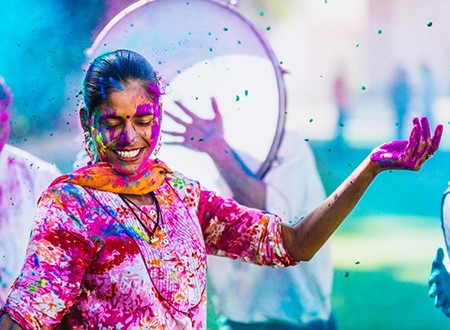Socially, culturally, and religiously, India is a vibrant and diverse country. Four important religions of the world, i.e., Hinduism, Jainism, Buddhism and Sikhism took roots on Indian soil. Every year offers opportunity to celebrate this diversity through the medium of festivals.
Each festival is grounded in a myth or a factual incident. Some of the festivals are celebrated to welcome a change in natural phenomena. The joyous and colourful festival of Holi will be celebrated on Sunday March 24th in many parts of India and by the Indian diaspora abroad. The festival changes dates from year to year because it corresponds with the full moon of Phalguna, the twelfth month of Hindu calendar.
There are two legends behind this festival. One is that Hiranyakashipu, a demon king who believed he was immortal god, did not like his son, Prahlad – a devotee of Lord Vishnu. Hiranyakashipu asked his sister Holika to take Prahlad in her lap and sit in a fire.
Holika had a blessing that fire would not burn her. The opposite happened. Holika was burnt to death and Prahlad, protected by Lord Vishnu, remained unharmed. Lord Vishnu appeared in the form of a half-lion and half-man and killed Hiranyakashipu.
According to another legend, Lord Krishna used bright colours to liven-up the faces of his female lover Radha and others. Holi is celebrated as Rang Panchami in Maharashtra; Shigmo in Goa; Kumaoni in Uttarakhand; Meduru in Andhra Pradesh and Lathmar in Uttar Pradesh. In Rudraprayag district of Uttrakhand, some villages do not celebrate Holi. It is a local belief that the goddess Tripura Sundari, of the region does not like the noise.
On the night before the main Holi festival, Holika Dahan is performed by burning wood and cow dung in bonfires. The next day people gather in the streets to dance, enjoy and throw powder and coloured water to soak others. A bhang (marijuana) mixed drink is quite popular to get to an ecstatic state.
In Sikhism, Holi is celebrated as Hola Mohalla a day after Holi. Guru Gobind Singh, the 10th Guru of Sikhs started it as a martial feat.
Holi also marks the welcoming of Spring, fertility, harvest and bright colours in the world after the dullness of Winter. Socially, on the day of Holi people bid goodbye to their old animosity. Foes turn into friends by applying colours on each other’s faces. Traditionally it is called ‘Holi Milan.’ (Bura na mano, Holi hai – Don’t feel bad, it is Holi) is a popular chant.
The rainbow of colors thrown in the form of powder or water also carries symbolic meaning. Red is considered the colour of life and marriage and is often worn by women in India on their wedding day. Blue is associated with divinity, as many Hindu gods, including Krishna and Vishnu are often portrayed in blue skin, while green is associated with nature. My message on Holi.
Better show your true colours.
Do not sail under false colours.
Break social barriers of colours.
You will pass with flying colours.
Holi is a personification of ‘multiculturalism’ in Canada, ‘unity in diversity’ in India and an ‘inclusion of race and ethnicity’ worldwide.
Zile Singh is a columnist, author, poet, human rights activist, golfer and a vipassana meditator. He can be contacted at [email protected]





